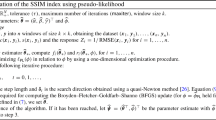Abstract
Statistical image restoration techniques are oriented mainly toward modelling the image degradation process in order to recover the original image. This usually involves formulating a criterion function that will yield some optimal estimate of the desired image. Often these techniques assume that the point spread function is known when the image is restored and indeed when we estimate the smoothing parameter. However in practice this assumption may not hold. This paper investigates empirically the effect of mis-specifying the point spread function on some data-based estimates of the regularization parameter and hence on the image reconstructions. Comparisons of image reconstruction quality are based on the mean absolute difference in pixel intensities between the true and reconstructed images.
Similar content being viewed by others
Explore related subjects
Discover the latest articles, news and stories from top researchers in related subjects.References
Archer, G. E. B. and Titterington, D. M. (1995) On some Bayesian regularization methods for image restoration. IEEE Transactions on Image Processing, 4, 989–95
Barone, P. and Rossi, C. (1989) Deconvolution with partially known kernel of non-negative signals. IAC Technical Report.
Bryan, R. K. and Skilling, J. (1980) Deconvolution by maximum entropy, as illustrated by application to the jet of M87. Monthly Notices of the Royal Astronomical Society, 191, 69–79
Chan, K. P.-S. and Kay, J. W. (1991) Smoothing parameter selection in image restoration. In G. Roussas (ed) The Proceedings of NATO ASI Conference on Nonparametric Functional Estimation and Related Topics, pp. 201–211, Kluwer Academic Press.
Craig, I. J. D. and Brown, J. C. (1986) Inverse Problems in astron- omy: a guide to inversion strategies for remotely sensed data. Adam Hilger, Boston, MA.
Galatsanos, N. P. and Katsaggelos, A. K. (1992) Methods for choosing the regularization parameter and estimating the noise variance in image restoration and their relation. IEEE Transactions on Image Processing, 1, 322–36.
Golub, G. H., Heath, M. and Wahba, G. (1979) Generalized cross validation as a method for choosing a good ridge parameter. Technometrics, 21, 215–23.
Gonzalez, R. C. and Woods, R. E. (1992) Digital Image Processing. Addison-Wesley, Reading, MA.
Gray, A. and Chan, K. P.-S. (1995) The effects of misspecification of blur in image regularization: a comparison of methods for smoothing parameter selection. In preparation.
Green, P. J. (1993) Contribution to the discussion of Vardi and Lee. Journal of the Royal Statistical Society, B 55, 604–605.
Gull, S. F. and Skilling, J. (1984) Maximum entropy method in image processing. IEE Proceedings F, 131, 646–59.
Hall, P. and Titterington, D. M. (1987) Common structure for choosing smoothing parameters in regression problems, Journal of the Royal Statistical Society, B 49, 184–98.
Hunt, B. R. (1973) The application of constrained least squares estimation to image restoration by digital computer. IEEE Transactions on Computers, 22, 805–812.
Kay, J. W. (1988) A comparison of smoothing parameter choices in image restoration. In J. Kittler, (ed) Pattern Recognition, pp. 587–96, Springer, New York.
Kay, J. W. (1990) A new choice of smoothing parameter for deconvolution problems based on estimation cross-validation. Research Report, University of Glasgow.
Rice, A. J. (1986) Choice of smoothing parameter in deconvolution problems. Contemporary Mathematics, 59, 137–51.
Savakis, A. E. and Trussell, H. J. (1993) Blur identification using residual spectral matching. IEEE Transactions on Image Processing, 2, 141–51.
Thompson, A. M., Brown, J. C., Kay, J. W. and Titterington, D. M. (1991) A study of methods of choosing the smoothing parameter in image restoration by regularization. IEEE Transactions on Pattern Analysis and Machine Intelligence, 13, 326–39.
Tikhonov, A. N. and Arsenin, V. Y. (1977) Solutions of Ill-posed Problems. Winston, Washington D. C.
Titterington, D. M. (1985a) General structure of regularization procedures in image reconstruction. Astronomy and Astrophysics, 144, 381–87.
Titterington, D. M. (1985b) Common structure of smoothing techniques in statistics. International Statistical Review, 53, 141–70.
Vardi, Y. and Lee, D. (1993) From image deblurring to optimal investments: maximum likelihood solutions for positive linear inverse problems (with discussion). Journal of the Royal Statistical Society, B 55, 569–612.
Author information
Authors and Affiliations
Rights and permissions
About this article
Cite this article
Chan, K., Gray, A. Robustness of automated data choices of smoothing parameter in image regularization. Stat Comput 6, 367–377 (1996). https://doi.org/10.1007/BF00143557
Issue Date:
DOI: https://doi.org/10.1007/BF00143557




